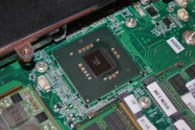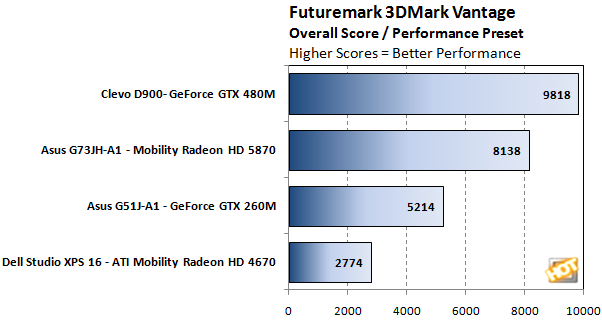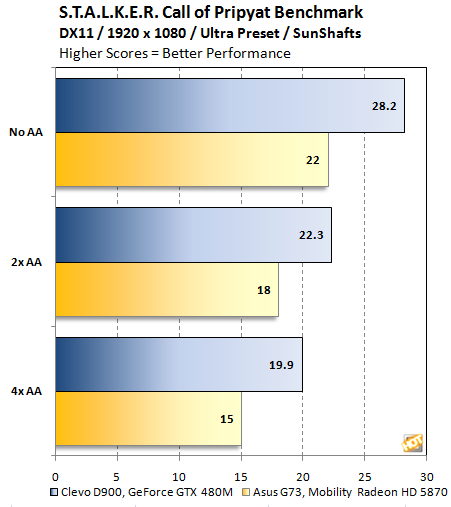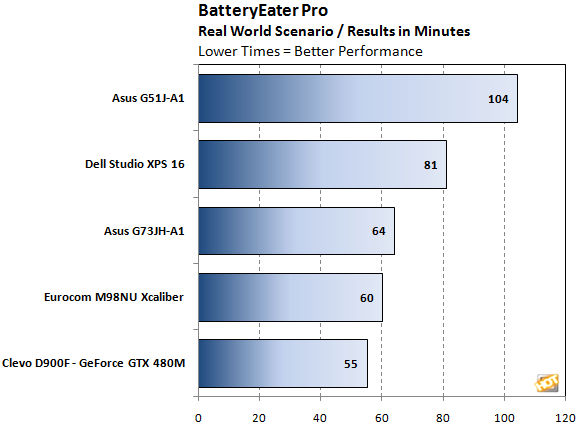 source: hothardware.com
source: hothardware.comLately, it seems like Desktop Replacement notebooks don't get any respect, at least in our humble opinion. The trend for thin and light mobile computing is massive these days, with good reason. However, there is a market and usage model for these beefier, significantly more robust machines the deliver the multimedia horsepower, gaming prowess and a general computing experience usually found in a desktop, but in a form factor that can easily be moved from room to room and a variety of environments. Take the use case of a Home Theater PC, for example. Instead of an emaciated media streamer, current generation Desktop Replacement notebooks can connect to a stereo media receiver or HDTV over HDMI and offer a ton more gaming and HD video performance. Drop in a USB wireless keyboard/mouse and media center remote and you're set. And that's not to mention the wireless HDMI technologies coming to market in the very near future that will enable coffee table control from across the room. You get the idea. There's a market niche' for the Desktop Replacement notebook, one that most power users can appreciate, but the thin-is-in crowd isn't exactly buzzing about.
It's a similar scenario to what can be observed in the flagship graphics card market segment, where performance bars are set high along with pricing, but the vast majority of sales volume shakes out to more mid-range product offerings. NVIDIA is a market juggernaut in this high-end arena and when it comes to notebook GPUs, the company religiously fires a cadence of mobile graphics product to follow-up their desktop counterpart releases.
In March of this year, NVIDIA launched their GeForce GTX 480, aka Fermi desktop graphics card and though this new killer GPU is both big and hot, there was little question it offered record-breaking performance. Almost shockingly, only a calendar quarter later, they're now ready with that card's notebook-targeted variant, the GeForce GTX 480M. We have one of the very first notebooks to hit the market in-house with the new GeForce GTX 480M under its hood. Fittingly, NVIDIA turned to Clevo to ODM a machine that would house their new mobile gaming frame-rate crusher and it took residence in the Clevo D900F quite comfortably.

GeForce GTX 480M Urban Assault Vehicle - Clevo's 17.1" D900 Gaming Notebook
|
| CUDA Cores | 352 |
| Gigaflops | 598 |
| Graphics Clock (MHz) | 425 MHz |
| Texture Fill Rate (billion/sec) | 18.7 |
| Thermal Design Power | 100 Watts TDP |
| Memory Clock (MHz) | 600MHz (2400MHz Data Rate) |
| Memory Interface Width | 256-bit |
| Memory Bandwidth (GB/sec) | 76.8 |
| NVIDIA SLI®-ready | 2-Way |
| NVIDIA 3D Vision Ready | Yes |
| NVIDIA PureVideo® Technology | HD |
| NVIDIA PhysX™-ready | Yes |
| NVIDIA CUDA™ Technology | Yes |
| Microsoft DirectX | 11 |
| OpenGL | 3.2 |
| Bus Support | PCI-E 2.0 |
| Certified for Windows 7 | Yes |
| Maximum Digital Resolution | 2560x1600 |
| Maximum VGA Resolution | 2048x1536 |

As is the case with ATI's Mobility Radeon HD 5870, the GeForce GTX 480M is much more akin to NVIDIA's mid-range desktop GPU, rather than the 480-CUDA core equipped GeForce GTX 480 desktop chip. In fact, if you look closely at the specs, you'll note that the GeForce GTX 480M is in reality a clocked-down version of the GeForce GTX 465. Whereas the GeForce GTX 465's core speed is 607MHz, the GTX 480M's core speed is 425MHz, though both chips employ 352 CUDA cores. The GeForce GTX 480M's memory interface speed (data rate) has also been scaled down a bit from 3206MHz on the desktop GeForce GTX 465 chip, to 2400MHz for the notebook-ready GeForce GTX 480M.
The net result is a notebook GPU solution that is currently unmatched in terms of high level specifications versus competitive notebook graphics chips, but also draws a lot less power than the nearest desktop equivalent chip in NVIDIA's line-up. TDP for the GTX 480M is 100 Watts, versus the faster clocked desktop version GeForce GTX 465 at 200 Watts. In comparison, AMD's Mobility Radeon HD 5870 has a 50 Watt TDP and offers a higher texel fill rate (28 Gtexels/sec versus 18.7 for the GTX 380M) but less memory bandwidth (64GB/sec versus 76.8GB/sec for the GTX 480M). But enough with the speeds and feeds, let's give you a closer look at the goods.
The fit and finish of the D900F is excellent and it comes with a myriad of connectivity options including HDMI and mini-Display Port outputs, 4 USB 2.0 ports, eSATA, an Express Card slot, SD/SDHC Flash card slot and of course Gigabit Ethernet, 802.11n WiFi and modem networking capabilities. The D900F has a full sized keyboard with numpad, a spacious touchpad and high gloss, almost "urethane-like" finish to it that does attracts smears but polishes up easier than most notebooks with a quick swipe of a soft cloth.


Caution High Temperature Parts - Ya think?
Under this glossy exterior is where all the magic happens however and once the magic gets revved up you know keeping it all cool took some creative engineering. In this case, three barrel or "squirrel cage" fans, as they are commonly known, cool an elaborate network of copper heat pipes and fine-pitched finned radiator heatsinks. Then fans draw air in underneath the system and push it out over the heatsinks. The far right side assembly in the shot above is in place to cool the CPU, while the other two fans cool a pair of heatsinks/pipes that keep the GPU cool. With a 100 Watt TDP chip in a notebook, you need this sort of exotic cooling.



Left: GPU, Chipset, Core i7 - Center: NVIDA's Mammoth GeForce GTX 480M - Right: Intel X58 Chipset
What's perhaps even more surprising is that this GeForce GTX 480M MXM module came equipped with a full 2GB of GDDR5 memory on board. As you can see, the rest is a fairly organized and cleanly laid-out design, with X58 system controller and memory in the middle, feeding the two data-hungry beast processors to either side of them. Excuse the thermal paste on the Core i7 940 chip. We figured you've seen one of those before and we wanted to leave the application in tact.
For testing purposes, we've focused our system cross-reference numbers on two primary machines, both with somewhat different configurations but directly competitive GPU (NVIDIA's GeForce GTX 480M and AMD's ATI Mobility Radeon HD 5870). As a result, the view here is not a direct correlation but rather a reference point for you to consider. In our gaming test, systems are heavily GPU-dependent, so the emphasis on other subsystem components and the CPU is much less pronounced. In these tests, we have assembled as close to an "apples-to-apples" comparison as we could deliver, given the test systems available. For the PCMark Vantage, we've provided one additional reference system to give you a general view of system performance relative to Intel's previous generation CPU architecture.
|
|
Eurocom M98U XCaliber
| Asus G73JH-A1
| Clevo D900F
|
The CPU-Z and GPU-Z shots we have for you below show our dynamic duo in action, though the Core i7 940 processor in this notebook is throttled down in idle mode.
As you can see in the left screen capture, the Core i7 940 stock frequency identified in the spec field is 2.93GHz though its multiplier has been dropped to 12 idling on the desktop here. In the right-hand shot, details of the GeForce GTX 480M can be seen, with its 352 unified shaders, 32 ROPs, 256-bit memory bus width and a whopping 2GB of GDDR5 memory.
|

Next we fired up 3DMark Vantage, which also has a bit more dependency on CPU performance, since it does have a module in the test suite specifically for software based rendering. Regardless, since this test is so widely known, we thought it made sense to throw it into the mix. From here on out, we'll be dialing up the eye candy full tilt on real game titles, which will place virtually all the emphasis on the GPUs being tested.
|
| The latest version of Futuremark's synthetic 3D gaming benchmark, 3DMark Vantage, is specifically bound to Windows Vista-based systems because it uses some advanced visual technologies that are only available with DirectX 10, which y isn't available on previous versions of Windows. 3DMark Vantage isn't simply a port of 3DMark06 to DirectX 10 though. With this latest version of the benchmark, Futuremark has incorporated two new graphics tests, two new CPU tests, several new feature tests, in addition to support for the latest PC hardware. |



The Unigine Heaven Benchmark v2.0 is built around the Unigine game engine. Unigine is a cross-platform real-time 3D engine, with support for DirectX 9, DirectX 10, DirectX 11 and OpenGL. The Heaven benchmark, when run in DX11 mode, also makes comprehensive use of tessellation technology and advanced SSAO (screen-space ambient occlusion), and it also features volumetric cumulonimbus clouds generated by a physically accurate algorithm and a dynamic sky with light scattering. In other, non-geek speak lingo, cutting-edge DX11 graphics are on display in this test.

|
Far Cry 2 is the sort of test that separates the men from the boys, or so to speak, when it comes to crushing GPU performance. We dialed this test up high to watch the GeForce GTX 480M sweat a bit.
|


For notebook GPUs, S.T.A.L.K.E.R. - Call of Pripyat could very well be "the new Crysis". It was punishing on both of our competitive notebook configurations.
|


With the built-in game test and benchmark tool dialed up to 1920X1080, frame rates for either GPU are basically unplayable. That said, the GeForce GTX 480M offered 25% higher frame rates in general and over 30% higher frame rates with higher levels of AA turned on.
Dirt 2 is another game title that AMD has spent a lot of time showcasing, so it should be interesting to see how the Mobility Radeon HD 5870 stacks up against the GeForce GTX 480M in this DX11-based racing sim.
|


When we considered that the new GeForce GTX 480M notebook graphics processor has a specified TDP (Thermal Design Power) of 100 Watts, we almost cringed at the thought of measuring battery life on this Clevo machine. Call us masochists but we're suckers for good data. We even put the machine on the other end of a power meter, just to get a sense of power draw off the D900F's rather honkin' large power brick.
|

Of power consumption, heat and noise -
So how much does this machine draw under full load? In short, a lot; as in almost crazy amounts of power for a notebook. After all, the D900F is pretty much a full-fledged desktop PC stuff into a notebook form factor. We measured the machine's power brick drawing 135 Watts at idle on the desktop and a little over 200 Watts under full gaming load. Obviously, this isn't what you'd call a "laptop," that is unless you prefer your lap rather uncomfortably warm. The D900F, with the GeForce GTX 480M within the confines of its notebook shell, needs to breath freely on a desk or table top. In fact, the machine's intake vents on the underside of the chassis are easily blocked, cutting off air-flow, if you place this notebook on your lap even for a moment, causing its cooling fans to spool up to much higher speeds.
Speaking of those fans, the D900F, at idle on the desktop, is a reasonably quite machine for a DTR notebook, but under heavy load, its cooling system is noticeably louder than many notebooks of this class that we've tested. We wouldn't say it's dramatically louder but enough that if you're looking for quieter machine of this class, you definitely will want to consider something with less juice coursing through its veins.
Performance Summary: NVIDIA's GeForce GTX 480M mobile GPU turned out to be the fastest notebook graphics processor we've seen to date, which is no surprise considering NVIDIA currently holds the single-GPU title on the desktop front as well. The GeForce GTX 480M was significantly faster in nearly all gaming benchmarks we performed with the one exception of H.A.W.X., where the chip clocked in barely ahead of the Mobility Radeon HD 5870 by a negligible margin. In every other case, from cutting-edge DirectX 11 titles like S.T.A.L.K.E.R. Call of Pripyat and Dirt 2, to demanding DX10 titles like Far Cry 2, the GeForce GTX 480M was on the order of 30% faster on average, with much larger gains shown in Far Cry 2, where the chip was up to 60% faster than its counterpart from AMD. All of this performance, however, does come at a cost of power consumption, heat and a bit of noise; which also was expected of course. The GeForce GTX 480M's thermal footprint (100W TDP) is also 2X that of the Mobility Radeon HD 5870.
 Taking stock in the final analysis of the NVIDIA's new GeForce GTX 480M, we're not shy about falling back on a tired, old cliche'. The GeForce GTX 480M notebook GPU "is what it is." This mobile GPU is a direct derivative of the desktop GeForce GTX 400 series, specifically the GeForce GTX 465 with its 352 CUDA cores, but with aggressive power gating when idle and top core clock speed 180MHz+ lower than its desktop-targeted sibling. Comparatively, the ATI Mobility Radeon HD 5870 is more akin to the Radeon HD 5750 on the desktop for AMD, with it's 700 stream processors. Whereas AMD delivers less than half the GPU in their flagship mobile part versus their top desktop chip, NVIDIA is delivering a device enabled with 75% of its compute resources but with a dramatically slower clock speed.
Taking stock in the final analysis of the NVIDIA's new GeForce GTX 480M, we're not shy about falling back on a tired, old cliche'. The GeForce GTX 480M notebook GPU "is what it is." This mobile GPU is a direct derivative of the desktop GeForce GTX 400 series, specifically the GeForce GTX 465 with its 352 CUDA cores, but with aggressive power gating when idle and top core clock speed 180MHz+ lower than its desktop-targeted sibling. Comparatively, the ATI Mobility Radeon HD 5870 is more akin to the Radeon HD 5750 on the desktop for AMD, with it's 700 stream processors. Whereas AMD delivers less than half the GPU in their flagship mobile part versus their top desktop chip, NVIDIA is delivering a device enabled with 75% of its compute resources but with a dramatically slower clock speed.The net-net here is that NVIDIA's new mobile chip is decidedly bigger, stronger and faster but also seriously more power-hungry and more challenging to cool. Comparing the two offerings is kind of like comparing a punishing, up-the-gut running fullback to a wide receiver; both get the job done, just in decidedly different ways. The fullback might need to take every third play off but the wide receiver might get drilled into the dirt by an outside linebacker, on a short route. In notebook speak, one of these GPUs is built for longer term, moderate-duty workloads, while the other is built for shorter bursts of intensity. Though if the machine is tethered to a wall outlet, you don't have to worry about taking many plays off, you just have to contend with a bit more heat and noise.
All told, the new NVIDIA GeForce GTX 480M is an impressive notebook graphics processor that's not for the faint of heart. If you're not concerned with being DX11 capable and don't mind a multi-GPU setup, there is better performance to be found in a previous generation GeForce GTX285 SLI-enabled notebook or the just announced but yet untested combination of Mobility Radeon HD 5870s in CrossFire we just showed you here. In addition, we've also been informed that build-outs from Eurocomm and others will also include a pair of GTX 480M chips in SLI as well. However, costs scale up significantly with dual-GPU notebook designs and there is always added complexity with multi-GPU setups from a software standpoint. So, in short, if you're the type that is a die-hard NVIDIA fan or you just want the fastest single notebook GPU configuration you can find that also supports the latest in DX11 rendering features, then the GeForce GTX 480M and the Clevo D900F is for you, provided you don't mind a notebook that draws power like a desktop PC. Then again, in this class of machines, that's why they're called "desktop replacement" notebooks.

| |
|
|














No comments:
Post a Comment